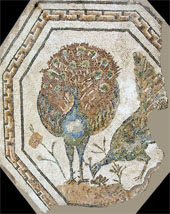
Mosaic of ancient Rome in Tbilisi
By Mariam Chanishvili
Friday, October 11
From October 10 to December 10, 2019, the Georgian National Museum hosts an exhibition featuring impressive mosaics from the Capitoline Museum of Rome.
The exhibition was inaugurated on October 9 at Georgian National Museum in the presence of Georgian national authorities, the diplomatic corps, academics, and civil society representatives.
The event is part of the "Vivere all'Italiana" program funded by the Ministry of Foreign Affairs and International Cooperation of Italy, a successful initiative in which the Italian Embassy in Tbilisi has proposed along with a busy calendar of high-level cultural events. It is part of the vast panorama of the activities by Roma Capitale, Department of Cultural Growth of Rome – Capitolina Superintendent of Cultural Heritage, aimed at promoting and enhancing their cultural heritage.
"A mosaic is also diplomacy, the art of bringing together many different aspects of a bilateral relationship, to consolidate the friendship between countries and develop new collaborations. Purpose of "Vivere all'Italiana" is to share with our friends what we have – the most precious: beauty, culture, our know-how, values and ancient treasures,” commented the Italian Ambassador Antonio Bartoli.
Curated by Claudio Parisi Presicce and Nadia Agnoli from the Rome museum, the display is a part of a series of Italian cultural events in Tbilisi.
"Cultural heritage does not belong to a single country, but the whole world. It is very important that the Georgians can admire the Italian works exhibited in our museum. I would like to thank the many bodies involved in this initiative, in particular, our Italian friends who do everything to bring Georgians closer to the wonderful Italian art ", concluded the mayor of Tbilisi, Kakha Kaladze.
The 21 mosaics of the exhibition, all found in Rome, cover a wide chronological period, which goes from the 2nd century BC to the 4th century AD and are therefore able to accurately attest to the technical evolution of the artisan workshops: the extraordinary creative and executive abilities of the workers and, at the same time, the changing fashions and taste of the clients from the republican era to the late imperial age.
The mosaics, were products of artistic handicraft of vast diffusion, destined to embellish the floors and walls of the homes of the wealthiest citizens and the middle class, as well as to decorate public buildings and funerary monuments, and for this reason they lend themselves to document, sometimes in a surprising way, the customs and society of ancient Rome.
The selected works, forming part of the most significant examples of ancient floor and wall mosaics, are part of the prestigious collection of the Capitoline collections formed between the late nineteenth and early twentieth century with the findings made during the great excavation and excavation works, which interested Rome the day after its designation as the new capital of the Kingdom of Italy (1870).
The Capitoline Museums is a single museum containing a group of art and archaeological museums in Piazza del Campidoglio, on top of the Capitoline Hill in Rome, Italy.



